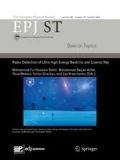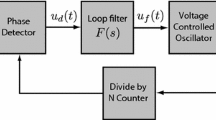Abstract
The performance of clock recovery phase-locked loop (PLL) can be severely degraded by unwanted spurious phase modulation, due to noise and nonlinearities associated with the transmission medium. Consequently, choosing appropriate circuit parameters to avoid or at least reduce these undesirable effects plays a crucial role in achieving a successful PLL circuit. This paper demonstrates that Melnikov’s method, originally proposed to identify chaos in dynamic systems, can be successfully used to establish the appropriate circuit parameters by determining the regions that ensure the correct operation under conditions of noise and nonlinearities, represented by periodic perturbations. This study considers the use of one of the most commonly adopted configurations for clock recovery, the second-order PLL with lag-lead filter, and provides a valuable tool for circuit dimensioning and design of clock distribution networks.








Similar content being viewed by others
References
H. de Bellescize, La reception synchrone. Onde Electr. 11, 230–240 (1929)
R.E. Best, Phase-Locked Loops, 6th edn. (McGraw Hill, New York, 2007)
F.M. Gardner, Phaselock Techniques, 3rd edn. (Wiley, Hoboken, 2005)
S. Bregni, A historical perspective on telecommunications network synchronization. IEEE Commun. Mag. 36(6), 158–166 (1998)
W.C. Lindsey, F. Ghazvinian, W.C. Hagman, K. Dessouky, Network synchronization. Proc. IEEE 73(10), 1445–1467 (1985)
L. Xiu, W. Li, J. Meiners, R. Padakanti, A novel all-digital PLL with software adaptive filter. IEEE J. Solid-State Circuits 39(3), 476–483 (2004)
M.A. Alvarez, U. Spagnolini, Distributed time and carrier frequency synchronization for dense wireless networks. IEEE Trans. Signal Inf. Process. Over Netw. 4(4), 683–696 (2018)
R. Follmann, E.E.N. Macau, E. Rosa, J.R.C. Piqueira, Phase oscillatory network and visual pattern recognition. IEEE Trans. Neural Netw. Learn. Syst. 26, 1539–1544 (2015)
P. Simek, J. Skramlik, V. Valouch, A frequency locked loop strategy for synchronization of inverters used in distributed energy sources. Int. J. Electr. Power Energy Syst. 107, 120–130 (2019)
X. He, X. Jin, M.H. Wang, M.H. Wang, D.J. Zhou, S. Goto, A 98 GMACs/W 29-Core Vector Processor in 65 nm CMOS. IEICE Trans. Fundam. Electron. Commun. Comput. Sci. E94A(12), 2609–2618 (2011)
E. Koskin, D. Galayko, O. Feely, E. Blokhina, Generation of a clocking signal in synchronized all-digital PLL networks. IEEE Trans. Circuits Syst.-II Expr. Briefs 65(6), 809–813 (2018)
J.N. Tripathi, V.K. Sharma, H. Shrimali, A review on power supply induced Jitter. IEEE Trans. Compon. Packag. Manuf. Technol. 9(3), 511–518 (2019)
J.R.C. Piqueira, Using bifurcations in the determination of lock-in ranges for third-order phase-locked loops. Commun. Nonlinear Sci. Numer. Simul. 42, 178–186 (2017)
J.R.C. Piqueira, Accidental phase modulation in second-order phase-locked loops. Commun. Nonlinear Sci. Numer. Simul. 62, 386–394 (2018)
J.R.C. Piqueira, S.A. Castillo-Vargas, L.H.A. Monteiro, Two-way master-slave double-chain networks: Limitations imposed by linear master drift for second order PLLs as slave nodes. IEEE Commun. Lett. 9(9), 829–831 (2005)
J.R.C. Piqueira, A.Z. Caligares, Double-frequency jitter in chain master-slave clock distribution networks: comparing topologies. J. Commun. Netw. 8(1), 8–12 (2006)
Y. Duan, H. Wu, M. Shimanouchi, M.P. Li, D. Chen, A low-cost comparator-based method for accurate decomposition of deterministic Jitter in high-speed links. IEEE Trans. Eletromagnet. Compab. 61(2), 521–531 (2019)
G. Yang, W. Zou, L. Yu, N. Qian, J. Chen, Investigation of electronic aperture Jitter effect in channel-interleaved photonic analog to digital converter. Opt. Expr. 27(6), 9205 (2019)
J. Guckenheimer, P. Holmes, Nonlinear Oscillations, Dynamical Systems and Bifurcation of Vector Fields (Springer, New York, 1983)
R.C. Weast, S.M. Selby, Handbook of Tables for Mathematics, 4th edn. (CRC Press Inc, London, 1970)
B.V. Chirikov, A universal stability of many-dimensional oscillator systems. Phys. Rep. 52(5), 263–379 (1979)
P.J. Holmes, Averaging and chaotic motions in forced oscillations. SIAM J. Appl. Math. 38(1), 65–80 (1980)
P.J. Holmes, J.E. Marsden, Melnikov’s method and Arnold diffusion for perturbations for integrable Hamiltonian systems. J. Math. Phys. 23(4), 669–675 (1982)
D. Hanselman, B. Littlefield, Mastering MATLAB (Prentice-Hall, New Jersey, 1996)
Timing Requirements of Slave Clocks Suitable for Use as Node Clocks in Synchronization Networks - Recommendation G.812, ITU-T (1997)
Timing Characteristics of Primary Clocks—Recommendation G.811, ITU-T (1997)
G. A. Leonov, N. V. Kuznetsov, A short survey on Lyapunov dimension for finite dimensional dynamical systems in Euclidean space. arXiv:1510.03835v2 [math.DS]. Preprint submitted to arXiv, DRAFT July 2 (2018)
B.A. Huberman, J.P. Crutchfield, N.H. Packard, Noise phenomena in Josephson junctions. Appl. Phys. Lett. 37(8), 750–752 (1980)
N.F. Pedersen, A. Davidson, Chaos and noise in Josephson junctions. Appl. Phys. Lett. 39(10), 830–832 (1981)
D. D’Humiers, M.R. Beasley, B.A. Huberman, A. Libchaber, Chaotic states and routes to chaos in forced pendulum. Phys. Rev. A 26(6), 3483–3496 (1982)
V.K. Mel’nikov, On the stability of the center for time-periodic perturbations. Trans. Moscow Math. Soc. 12, 1–57 (1963)
S.N. Chow, J.K. Hale, J. Mallet-Paret, An example of bifurcation to homoclinic orbits. J. Differ. Equ. 37, 351–373 (1980)
Acknowledgements
All the data used in this paper are available in the Internet by following the links given in the references. JRCP was supported by the Brazilian Research Council (CNPq), Grant Number 302883/2018-5.
Author information
Authors and Affiliations
Corresponding author
Ethics declarations
Conflict of interests
The author declares that there is no conflict of interests regarding the publication of this article.
Appendix: Heteroclinic chaos and Melnikov method
Appendix: Heteroclinic chaos and Melnikov method
Considering that chaos refers to apparently stochastic behaviors in nonlinear dynamical systems described by differential equations, experimental work was developed showing the existence of chaotic attractors in pendulum and Joseph junction time evolution, when excited by signals following: \(A + B\sin \omega \cdot t\), with A, B and \(\omega \) constants [28,29,30].
For this type of system, theoretical development was conducted in [21, 22, 31] modeling the experiments in an accurate way by treating the whole system as a perturbation from a Hamiltonian, constructing the Melnikov measure [19] that can be used to predict chaotic behaviors as described in this section.
For systems presenting chaotic behaviors, there are regions in the phase space such that, starting the temporal evolution in two closed points, as time passes, the distance between their destinations increases exponentially. If a system presents saddle equilibrium points, i.e., a singularities related to four distinct trajectories, two tending to the singularity as \(t \rightarrow +\infty \), called stable manifolds; and two as \(t \rightarrow -\infty \), called unstable manifolds. If there are transversal interceptions between the stable and unstable manifolds associated to a saddle equilibrium point indicate this kind of dynamical behavior [19], i.e., the presence of heteroclinic points in these interceptions is responsible for the onset of chaos [31].
There are slightly different techniques to detect heteroclinic chaos, firstly described in [23, 31, 32]. In [23], a version of the Melnikov’s method was developed for second-order Hamiltonian systems with a heteroclinic orbit, with an additional periodic perturbation. As it is shown in the next section, the accidental phase modulation in PLLs can be modeled following the same type of equation, justifying this brief description of the method to be used.
Considering second-order systems described by:
with \((u,v) \in \mathfrak {R}^{2}\); \(p_{0}, p_{1}, q_{0}\) and \(q_{1}\) continuous functions; \(\theta \in \mathfrak {R}\); \(T \in \mathfrak {R}_{+}\); and \(\epsilon \in \mathfrak {R}\), \(\epsilon > 0\), and small.
Concerning systems described by (24), they can be viewed as described by \(\epsilon \)-perturbations of the autonomous equations:
About equations (24) and (25), the following hypothesis are supposed to be true:
-
H-1: they present two hyperbolic saddle points: \(x_{0}{'} = (u_{0}{'},v_{0}{'})\) and \(x_{0}{''} = (u_{0}{''},v_{0}{''})\), connected by a trajectory \(\varGamma _{0}\);
-
H-2: if \(x_{0} \in \varGamma _{0} \Rightarrow \) \(\lim _{t\rightarrow +\infty } x(t) = x_{0}'\), and \(\lim _{t\rightarrow -\infty } x(t) = x_{0}'';\)
-
H-3: functions \(p_{0}, p_{1}, q_{0}\) and \(q_{1}\) are \(2 \cdot \pi \) periodic in \(\theta \), and of \({\mathcal {O}} (\epsilon ).\)
Lemma 1
Under the hypotheses H-1, H-2 and H-3, the following statement can be proved:
-
Equations (24) and (25) present orbits \(\gamma '\) and \(\gamma ''\), respectively, with stable and unstable manifolds \(E^{s}(\gamma '), E^{u}(\gamma '), E^{s}(\gamma '')\) and \(E^{u}(\gamma '')\) with transversal section \({\varSigma _{t_o} = (u,v,\theta ) \in \mathfrak {R}^{2} \times S^{1} \mid _{\theta =t_0}}\).
The proof of this Lemma can be found on page 69 of [22].
Considering the facts described, Melnikov proved [31] that solutions of (24) can be written as:
Consequently, the solutions appearing in the stable and unstable manifolds, \(E^{s}(\gamma ')\) and \(E^{u}(\gamma '')\), belonging to a compact neighborhood of the equilibrium points, can be expressed by:
with \(x_0\) being the non-perturbed orbit of \(\varGamma _0\).
It must be observed that \(x_{0}(t)\) is a heteroclinic non-perturbed orbit; \(x_{\epsilon }^{s}(t)\) and \(x_{\epsilon }^{u}(t)\) are the stable and unstable perturbed orbits, respectively. The Melnikov method evaluates the distance between \(x_{\epsilon }^{s}(t,t_o)\) and \(x_{\epsilon }^{u}(t,t_0)\), because if they intercept each other in one point, there is an infinite number of interceptions between these orbits, originating the Smale horseshoe [23] in the Poincaré map dynamics [19], with a set of unstable orbits with different periods, that seem to be non-periodic recurrent orbits.
This fact occurs if the separation measure between \(x_{\epsilon }^{s}(t,t_o)\) and \(x_{\epsilon }^{u}(t,t_0)\), here called \(d_{\epsilon }(t_0) = \varDelta (t_0)\), presents transversal zeros, i.e., there is a \(t^{'}_{0}\) such that: \(\varDelta (t^{'}_0=0)\) and \({\dfrac{d\varDelta }{dt} \mid _{t^{'}_0}}=0\).
Considering the notation and conditions described in this section, as shown in [23, 32], the Melnikov measure is given by:
In equation (28):
-
for \(f_{0} = (p_0,q_0)\) and x(u, v); \(f_{0} \wedge x = p_0 \cdot v - q_0 \cdot u\);
-
\(x_{0}(t) = (p_{0}(t),q_{0}(t))\) is the solution of the non-perturbed system, i.e., of Eq. (25);
-
\(x^{s}(t)\) and \(x^{u}(t)\) are the solutions of the perturbed system, i.e., of Eq. (24), belonging to \(E^{s}(\gamma ^{''})\) and \(E^{u}(\gamma {'})\), starting in \(x^{s}(t_0)\) and \(x^{u}(t_0)\) in section \({\varSigma _{t_o} = (u,v,\theta ) \in \mathfrak {R}^{2} \times S^{1} \mid _{\theta =t_0}}\).
The measure defined by Eq. (28) is useful to look for chaotic attractors for second-order systems. However, in practical cases, it is difficult to obtain the analytic expressions for \(x^{s}(t_0)\) and \(x^{u}(t_0)\) and, consequently, it is usual to expresses the Melnikov measure as the approximation:
with:
Calculating the first term of the power approximation for the solution, expressed by the Jacobian [19, 22], it can be written that:
with J representing the Jacobian matrix.
If the unperturbed system is Hamiltonian [19], the exponential term vanishes, resulting that:
This methodology was applied to the PLL problem identifying its dynamic equation with (24) and constructing the Melnikov measure for this particular problem. Then, searching for transversal zeros in the measure, the forbidden parameter regions were found, concerning accidental phase modulation as a perturbation.
Rights and permissions
About this article
Cite this article
Piqueira, J.R.C. Melnikov’s method applied to accidental phase modulation phenomenon. Eur. Phys. J. Spec. Top. 230, 3449–3456 (2021). https://doi.org/10.1140/epjs/s11734-021-00229-3
Received:
Accepted:
Published:
Issue Date:
DOI: https://doi.org/10.1140/epjs/s11734-021-00229-3




